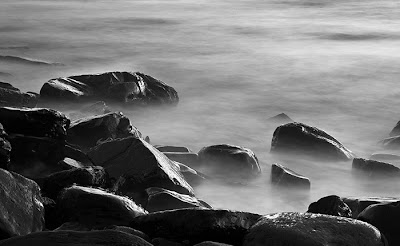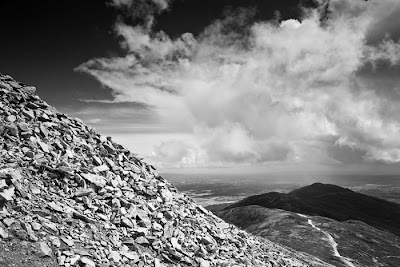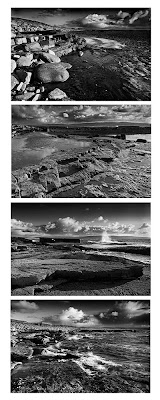Here is the second and final part of the Tips and Tricks to shoot better landscapes.
The tips were taken from 'Outdoor Photography' magazine in their December issue.
"101 ways to take better landscape photographs - Improve your landscape technique by following our extensive guide. We asked 10 of your favourite outdoor photographers for their expert advice and tuition."
I have only posted 51 between the two posts which I use on a regular basis. So enjoy the following tips and lets hope you have learned something:
28. Be Original: Use your widest or smallest aperture to take depth of field to extremes. If you want to interpret the landscape in your own way then depth of field should be seen as a key tool.
29. Emphasise scale of landscape: With small apertures, exploit front-to-back sharpness by including foreground interest. This will emphasise the scale of landscapes, especially when you're using a wideangle lens.
30. Look for linear features: It pays to look for linear features which run front to background ,such as dry-stone walls or plough lines in fields. Set your smallest aperture and include them in your compositions for pictures with a dynamic look.
31. Hyperfocal distance: focusing at the hyperfocal distance gives you the maximum depth of field for any given aperture. To do this, first set your lens to manual focus and then refer to the depth of field scale on the lens barrel (if you have one). Then adjust the focusing ring so that the infinity marker is aligned with the chosen aperture value. The lens is now focused at the hyperfocal distance.
32. Appreciate light: in all its many variations and learn to see it to your advantage.
33. Sunrise and sunset: These are the conventional times for the majority of landscape photography. The low angle of the sun creates modelling of the landscape, conveying a sense of depth, while the apparent warmth of the light adds emotional impact.
34. Into the sun: Choose a morning or evening with broken cloud and wait for the moment when the sun begins to appear in a gap, before it gets too strong. ND grad filters will be vital to retain a balanced exposure.
35. Backlight: Autumn leaves, water droplets on trees and plants, and ice all lead themselves to a touch of backlighting for that added sparkle.
36. Explosive light: On a stormy day brave the elements and you may be rewarded with stunning moments when the sun bursts through a gap in the clouds. Nothing beats a landscape set ablaze with dark clouds glower in the distance.
37. Mist and fog: perfect for isolating subjects and adding a sense of mystery to your shots. Mist can diffuse sunlight wonderfully, creating an ambient glow in the landscape.
38. Maximise image quality: buy the best quality filters you can afford.
39. Positioning your polariser: A polariser's greatest effect can be found at 90 degrees to the sun. To help find this angle, make a 'gun' with your forefinger and thumb. Then, simply point at the sun and rotate your thumb 90 degrees either side.
40. Using multiple filters: Vignetting can prove a problem when using multiple filters or a holder. Before shooting, check for darkening of the frame's corners by taking a test shot of a light coloured subject, like the sky. If vignetting is present, adjust accordingly.
41. Remenber: Filters can't magically transform a poor picture or boring scene into a good one; they can only enhance an already well lit and composed image.
42. White Balance: If you shoot digitally, your camera's white balance setting can be utilised as a great form of creative in-camera filtration. Select a low colour temperature to create a cool colour cast, or a high one to add a warm, orange hue.
43. Expose for the highlights: When shooting for slide film or digital you must expose for the highlights. Over-exposed highlights will contain no information and will ruin your picture.
44. Expose to the right: When shooting digital expose to the right ie adjust your exposure so that the histogram gets as close to the right-hand side as possible without clipping the highlights.
45. Contrast is the enemy: of colour photography. Over-exposed areas will appear white; under-exposed areas will appear black, regardless of their actual colour. If contrast is too great, consider using a neutral density graduated filter. If this isn't an option, consider changing your composition.
46. Sunny 16 rule: If you find yourself without a light meter, remember the 'sunny 16' rule. The correct exposure for an average scene taken on a bright sunny day is f/16 at 1 over the ISO setting ie at iso 100 use 1/100sec at f/16.
47. Exposure compensation: Your camera's meter expects the subject to be a mid-tone grey (18%) and will suggest an exposure that will recreate this. If your subject is brighter (eg a snow scene) you must over expose ie dial in positive exposure compensation.
48. Shoot in RAW: There's simply no sense in shooting Jpegs if your camera can capture Raw files. Like the latent image on undeveloped film, the raw file can be 'processed' in unlimited ways and can never be overwritten.
49. Go non-destructive with Adjustment layers: If you apply Photoshop edits as adjustment layers, you can keep the image in a state of permanent flux. This way, there's no need to make a long sequence of correct edits, as you can go back and change earlier commands until you've created the desired effect.
50. Sharpen as the final command: Always apply the sharpening command as the final step in your editing sequence. Just like using a focus finder to tweak your enlarger lens in the darkroom, sharpening extracts the maximum detail from your image, but if additional edits are applied afterwards, the image will start to get noisy.
51. Print with profiles: If you've spent hours fiddling around with printer software, then its time to use proper paper profiles to print with. Available as a free download from all good paper manufacturers, profiles are tiny data files that translate the colour of your pixels for use with specific ink, paper and printer combinations.



















